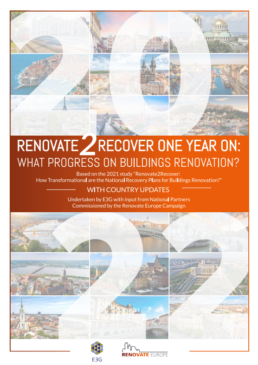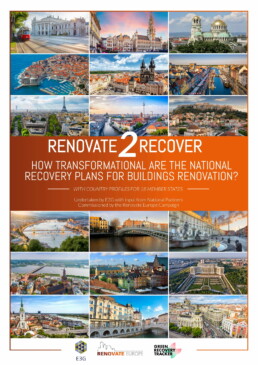Renovate2Recover One Year On: What progress on buildings renovation?
The National Recovery and Resilience Plans (NRRPs) were approved in the aftermath of COVID in 2021, well before the war in Ukraine and subsequent energy prices and cost of living crisis. The aim of the Recovery Facility is to provide a stimulus which would lift Member States’ economies out of the post-COVID slowdown, while boosting digitalisation and helping Member States to achieve the EU’s 2030 and 2050 climate goals.
The energy crisis acts as an additional driving force for pursuing the buildings-related reforms and investments planned in the NRRPs. As Commission President von der Leyen stated in October 2022, “faced with war, with a fossil fuel crisis, the arguments in favour of the Renovation Wave have only become more pressing. Investing in renovation is a no regret option.”
In 2021, the Renovate2Recover study found that amongst the 18 Member States’ NRRPs analysed, €39.9bn* was allocated buildings renovation (about 8% of total). This brief provides an update on progress after one year of implementation, and looks at the work which has begun to unlock buildings-related investment worth at least €28bn.
This briefing looks at which buildings-related measures were implemented, which targets and milestones were met, and what financial support was provided to Member States until the end of September 2022. There has been slow but steady progress on buildings-related measures led by reforms and entry into force of new financing programmes.
*This figure has been updated to approx. €46 bn across 18 MS with value for Italy increased from €8.6bn to €15.4bn (original value was based on a draft plan).
Updated maximum grant allocations in the National Recovery and Resilience Plans
The European Commission has published the updated grant amounts for Member States under the Recovery and Resilience Facility (RRF). This update is taking place because 30% of the initial maximum grant amount was based, in part, on real GDP growth estimated in the 2020 Autumn Economic Forecasts and, according to the RRF regulation, this had to be updated based on the actual Eurostat data by 30th of June 2022. To enter into effect, these changes will have to be adopted in an updated Council Implementing Decision.

Wondering what is the latest update on the national recovery plans?
The REC team along with its National Partners and E3G will be monitoring the implementation of the buildings-related elements of the national recovery plans in 19 Member States: Austria, Belgium, Bulgaria, Croatia, Czechia, Denmark, France, Germany, Greece, Hungary, Ireland, Italy, Latvia, Netherlands (as soon as it is made available), Poland, Romania, Slovakia, Slovenia and Spain.
Monitoring the national recovery plans will be done thanks to the Renovate2Recover Study, undertaken by E3G in close cooperation with Renovate Europe’s National Partners, and the information available on the European Commission’s Recovery and Resilience Scoreboard.
Each country page includes:
- a summary of the total investments allocated to buildings, and in particular for energy renovation;
- a timeline of the latest disbursements;
- an indicative timeline for future payment requests;
- a table listing in detail the buildings-related investments and reforms that each Member State includes in its NRRP. The measures have been categorised under their specific instalments.
Renovate2Recover: How transformational are the National Recovery Plans for Buildings Renovation?
The Renovate2Recover Study, undertaken by E3G for the Renovate Europe Campaign and launched on the 13th of October 2021 at the REDay2021 Conference, assesses the buildings-related elements of the National Recovery and Resilience Plans (NRRPs) in 18 Member States: Austria, Belgium, Bulgaria, Croatia, Czechia, Denmark, France, Germany, Greece, Hungary, Ireland, Italy, Latvia, Poland, Romania, Slovakia, Slovenia and Spain. The aim is to understand whether NRRPs position countries to achieve longer-term targets for more and deeper renovation, and whether NRRPs have the potential to be ‘transformational’ on the path to achieving national goals set out in the Long Term Renovation Strategies and EU goals set out in the Renovation Wave strategy. The Study was developed by E3G, bringing its experience of working on the Green Recovery Tracker, and was delivered in close cooperation with Renovate Europe’s National Partners and Campaign Office.
Renovate Europe’s National Partners have made substantial and crucial contributions to the content and value of this Study. They are perfectly positioned with their understanding of the national context and contacts with national governments to contribute to the assessment of the NRRPs, and, crucially, to act on the opportunities that are identified in each Country Profile to improve and support the implementation of NRRPs across the EU.
Each Country Profile is accompanied by an annex that sets out, in more detail, the various programmes and reforms that each Member State includes in its NRRP. Where possible, the funding allocation for each programme is also included. The content of these annexes is drawn from an analysis of the European Commission’s assessment of the NRRPs and the European Council’s Implementing Decision for each NRRP.
What Buildings Elements in the National Recovery Plans?
This short document seeks to provide a checklist of key elements to be included for buildings in the National Recovery & Resilience Plans (NRRPs), taking into account upcoming legislative developments (revision of the Energy Efficiency Directive and Energy Performance of Buildings Directive). Tying the National Plans to a long-term regulatory perspective will increase the absorption rate of EU funding and improve the implementation of EU buildings policies on the ground, thereby contributing to multiple benefits for Member States, their businesses and their citizens.
- Allocation for Capacity Building or Technical Assistance
- Segment-based approaches with Measurable Outcomes
- Deep renovations achieving low energy consumption levels
- Support to Upskilling the Workforce
- Focus on scaling up existing renovation schemes
- Uptake of Loans and other Financial Instruments
- Better Aggregation of Data to measure impact
Prioritise Energy Renovation in the National Recovery and Resilience Plans!
At the July European Summit, EU leaders agreed a recovery package and the 2021-2027 budget to help rebuild the EU after the pandemic and boost investment in green and digital transitions. This is a unique opportunity to allocate this money towards energy renovation.
Member States are currently drafting National Recovery and Resilience Plans to be submitted to the European Commission as from the 15th of October, outlining where they will allocate the funding to be awarded from the EU Recovery Package.”
Prioritise energy renovation in the National Recovery and Resilience Plans!
- Read here an FAQ document explaining “Why should I prioritise energy renovation in the National Recovery and Resilience plan for my Member State?”
This provides short answers to why buildings are so important for our health, why energy renovation is in line with the EU’s growth objectives and green priorities, what is the link between the Renovation Wave and the National Recovery Plans, whether the renovation sector is ready to deliver, and what kind of funding needs to be included for energy renovation in the National Plan.
- Read here a Practical Guide explaining how to include energy renovation: “National Recovery Plans, European Semester & DG REFORM: How Energy Renovation fulfils all criteria to disburse EU Recovery Funding fast in your MS”
This guide looks at some the practical aspects: how energy renovation complies with the assessment criteria, how it ties up with the European Semester, how DG REFORM’s support can help finance energy renovation, how to access this technical support and what other funds are available for energy renovation.


